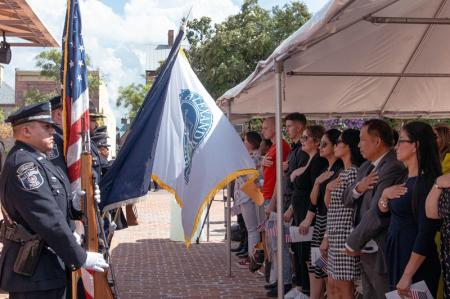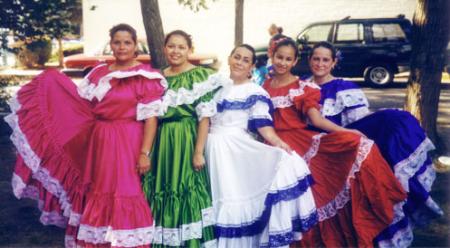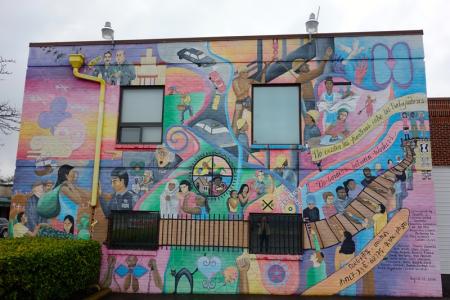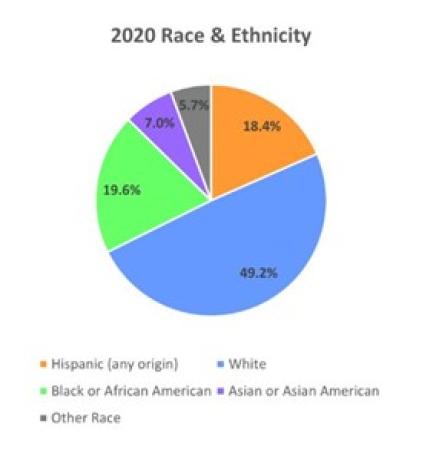New Arrivals
New Arrivals
Newcomers from around the country and the world have shaped the diverse make-up of Alexandria’s neighborhoods and population. The City has a long history of receiving immigrants, from its early settlement by Scots to influxes of Germans in the 19th century following the 1848 European revolutions. From World War II to recent decades, social unrest, war, religious and political persecution, and the quest for new opportunities have brought many from all over the globe to settle in our area. Data from the 2020 Census shows that 51% of Alexandria’s population is now of non-white and ethnically diverse origin.
Today, Alexandria’s neighborhoods reflect this rich cultural diversity, from the Central American heritage of Chirilagua in Arlandria to Afghani and Ethiopian communities in the West End. Recollections of individuals interviewed for oral histories reveal how they have kept connected with the cultural traditions of their native countries while transitioning to a new American way of life. Their stories reflect resilience, determination, and how their multicultural backgrounds have enriched the character of Alexandria’s neighborhoods.

City of Alexandria.


Office of Historic Alexandria.
What languages are spoken in your neighborhood?
Rhoda Worku, born in Ethiopia, settled in Alexandria in 1983, owner of the Caboose Café in Del Ray; interviewed by Krystyn Moon, May 20, 2015:
I wasn’t intending to do the Ethiopian food at all, but people were coming as soon as we opened. They were teasing me. They said, “When are you going to feed them some injera [a spongy Ethiopian bread]?...I said, okay. One day I took people’s names and sent them an email. I’m going to have injera”…So I started vegan, only the vegetarian, because the people from yoga [down the street] keep asking me to do vegetarian…One hundred percent of my clients are from the neighborhood.
Aida Abdul-Wali, from Ethiopia, lived in Alexandria since 1980; interviewed by Aspasrin Suvanasai, August, 25, 2015:
I might not have been born in America, but this is home now.
Evelin Urrutia, immigrated from El Salvador in 1993 at age 16; interviewed by Sue Kovack Shuman, April 13, 2015:
During that time [1990’s] it was really hard to get a good education…one of the biggest challenges that I faced was for me to get adapted to a new school system and get that education that I was dreaming for…I was one of the students who was in the front line demanding bilingual counselors so that we could have support in place…We ended up getting a bilingual counselor, but for me it was kind of late already in the process because I was almost out of the school…But, I was so excited that I was doing something that was going to be beneficial to other students that were coming along.
Medhi Aminrazavi, from Iran, moved to Alexandria in 1985, became Professor of Religion and Philosophy at the University of Mary Washington; interviewed by Apasrin Suvanasai, July 4, 2015:
We really liked Alexandria. There was a fairly large Iranian community there and what we particularly liked about it was that the first school that taught Persian language (Farsi) was established in Alexandria…That was a chaotic period, but yet thousands of Iranians that would come to the area were learning how to organize themselves and do what other immigrants had done before us: to be networking, and to have meetings, and there were community centers which we could use.
Vineeta Anand, born in India, immigrated to America in 1982 and eventually settled in Del Ray; interviewed by Krystyn Moon, March 14, 2015:
....the best thing about this neighborhood, is it truly feels like a neighborhood. People are open-hearted and will respond [on the community list serve]…And so people responded with plumbers and recommendations…And there had been a discussion on the list serve some months earlier about chai [tea] and how you make it here…so I sent a recipe for chai on the list serve and I got such wonderful emails from people saying “Thank you” and I met an Indian in the neighborhood because of that email…So, this neighborhood has evolved…There are Indians married to Americans or Indian couples living [here]. You can see the Indian names on the list serve.”
Jonathan “Jon” Liss, community advocate for immigrants and low-wage workers, and co-founder of Tenants and Workers United; interviewed by John Reibling, April 14, 2015:
…we would identify community issues that were affecting youth and work on those issues and youth would lead the work…Our youth made a number of murals that we have hanging around the Arlandria area…They would often study the history of murals in Latin American art. They would figure out what they wanted to draw on. They would visit other murals. They’d work with an artist…and they would actually get up either on plywood or the scaffolding and paint murals…there’s at least three that are still around.
Narges Maududi, born in 1979 in Afghanistan, arrived in Alexandria in 1991 as a refugee; interviewed by Aspasrin Suvanasai, June 9, 2015:
…when we moved here…we were the traditional people coming here and blending in with the family that was here. My younger cousins that grew up here, they had their own traditions: they celebrated Christmas, they celebrated Thanksgiving, and those are new holidays for us. …So, we adopted a lot of the Western or American holidays…we have full Thanksgiving dinners now…But, it was like a physical change, we could see things getting added and things disappearing, like other Afghan traditions.
“I think one of the things that I still try to do is cook. You know, Afghan cooking…My mom always had dinner ready and every so often, she would have people come over. It was traditionally like, once a week that we would get together. So, those were the things that she did to keep the family together and keep the traditions going.”
Tu-Ahn Nguyen, left Vietnam with her family in the late 1970s, came to Alexandria in 1984, and later opened a boutique in the City; interviewed by Daniel Lee, June 4, 2015:
...when we escaped Vietnam by boat, we didn't take anything...one thing I took was...a framed wooden picture of my Saint Theresa, that one of the...head mothers at the Convent of the Carmelite gave it to me. So I carry that with me on the boat and I still have it, in the original frame.
Myriam Lechuga, immigrated from Cuba in 1967 at age 12; interviewed by John Reibling, June 13, 2015:
So once we were settled there and I was in school, in Polk Elementary School. I then started to make some friends…There were other kids who went to school and lived in the neighborhood so we would get together and be outside playing or whatever…Maybe there were more Cubans or just because I knew more Cubans then, but there were—I had two Cuban friends. So I had a friend in school also Cuban refugees, immigrants at the time.
Population Trends
Current data based on the 2020 Census shows that the fastest growing community in Alexandria is Latino or Hispanic, nearly tripling in size since 1990 and comprising 18% (or 29,372) of the City’s population. Hispanic residents make up a large part of the Arlandria-Chirilagua, Eisenhower West/Landmark, and the Beauregard Street corridor neighborhoods.
